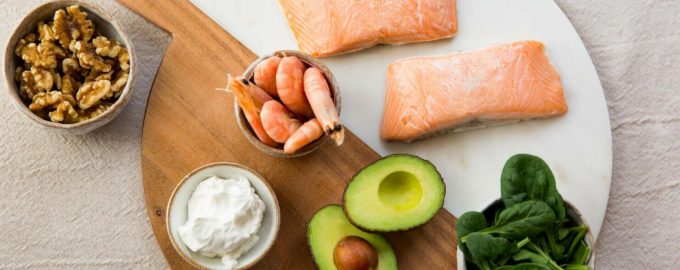By now, you probably know fat isn’t the enemy. In fact, certain types of fat are actually good for you and maybe even help you live longer.
One study found that people who ate a high fat, low-carb diet (as opposed to a low-fat, high-carb diet) were healthier overall: They lost more weight and had better cholesterol levels (and a decreased risk of heart disease) than those in the other group. While, overall, large studies have shown that what matters most for weight loss is consistency and calorie deficit–not exact diet–increasing your intake of healthy fats still offers plenty of health benefits that extend well beyond the scale.
So yes, fat can be your friend (that’s why you’ll see us say things like “yummy, heart-healthy fats” on our menu). But it’s important to understand the various types of fat so you can make smart choices. Keep reading to learn everything you need to know about healthy—and unhealthy—fats.
Types and examples of healthy fats
We’ll go more in depth in a second, but here’s a high-level look at types of healthy fat you need to know. The fats below are two subtypes of the larger unsaturated fat group, which is the healthy alternative to saturated fats.
- Monounsaturated fats (avocado, almonds, olive oil, dark chocolate)
- Polyunsaturated fats (fatty fish, walnuts, tofu, sunflower seeds)
If understanding the difference between monounsaturated and polyunsaturated fats feels overwhelming, that’s OK. Some nuts have monounsaturated fats while others have polyunsaturated fats. Same with seeds. Understanding those distinctions is great for boosting your overall health, but understanding the difference between saturated and unsaturated fats and being able to identify which larger category your foods fall under is a great start.
Omega-3 fatty acids are another type of healthy fats you might have heard of before. They’re not listed out here because they’re simply one type of polyunsaturated fat. The fatty fish under this type of fat have these omega-3s that are loaded with health benefits.
Types and examples of unhealthy fats
It’s worth noting right off the bat that a balanced diet has room for some “unhealthy” fats. These unhealthy fats are found in many foods with which you may have fond memories, like nostalgic snack foods. Minimizing how often and how much of these foods you eat may be a more sustainable approach to these unhealthy fats than trying to eliminate them from your diet altogether.
There are two main types of unhealthy fats:
- Saturated fats (red meat, full-fat dairy, coconut oil, palm oil)
- Trans fats (fried foods, baked goods, margarine)
You may have noticed that coconut oil, which has been embraced by the wellness industry for a while, is listed under unhealthy fats. While some studies have shown positive effects of the fat in coconut, other studies have underscored potential dangers. It’s one of several hotly debated topics in nutrition.
Are saturated fats healthy?
The jury is still very much out on this question. What’s more clear is that saturated fats may not be as bad for us as nutrition experts once believed. Past studies, for example, have found that a diet high in saturated fats may increase inflammatory markers. But more recent research on the potential connection between this type of fat and inflammation found no or very little effect on inflammatory markers.
The science is just as unclear on how saturated fat affects heart health. Plenty of studies show an association between saturated fat consumption and the increase of risk factors for heart disease such as increasing the ratio of “bad” LDL to “good” HDL cholesterol levels, “bad” LDL cholesterol, and levels of a main component of LDL. But all of these studies have failed to make a direct connection between saturated fat intake and heart disease itself. In fact, a review of 76 various studies on this type of fat and heart health that looked at a total of 659,298 participants found no significant association between the two.
It seems like it’s still a matter of time before we have a clear answer, but there may also be shades of grey here. Saturated fat that comes from fast food, fried foods, and baked goods with added sugar may negatively affect your health while other saturated fats such as coconut, grass-fed beef, and organic full-fat dairy may offer benefits. The exact place of saturated fat in your diet may also be determined by your individual health markers.
Saturated vs unsaturated fat
It’s up to you and your healthcare provider to decide what role saturated fat will play in your dietary habits. But no matter what that decision is, it’s helpful to understand how they differ and how to spot the difference in some kitchen staples.
Fats are made up of carbon, hydrogen, and oxygen. Saturated and unsaturated fats differ slightly in their chemical structure. Saturated fats are saturated, or completely filled up with, hydrogen atoms and only have single bonds between their carbon atoms. Unsaturated fats have at least one double bond in their chemical structure between carbon atoms. All of that technical language means that, in many cases, you’ll be able to spot the difference between a saturated and unsaturated fat with your naked eye.
The difference is clear with cooking oils: Saturated fats are solid at room temperature, like coconut oil. Unsaturated fats are liquid at room temperature, like olive oil. From there, it’s a matter of learning which fats fall into which category. Fats from land animals, like fatty cuts of meat and dairy products tend to be saturated. Fats from many plants and fish tend to be unsaturated. But there are exceptions, like the coconut.
Monounsaturated fats
Found in: Avocados, nuts (almonds, hazelnuts, pecans), seeds (pumpkin and sesame), olive oil, and dark chocolate.
When it comes to unsaturated fats, there are two types: monounsaturated and polyunsaturated. Monounsaturated fatty acids (known as MUFAs) are plant-based fats that can improve your heart health by upping your good cholesterol (HDL) and lowering your bad cholesterol (LDL). Another great benefit? Research suggests they may help you lose weight if that’s your goal. One study found that foods high in MUFAs keep you full longer than foods with saturated fats, which may help prevent overeating. But this also benefits people who simply want to avoid that mid-afternoon urge to snack because it’s a distraction.
Polyunsaturated fats
Found in: Fatty fish (salmon, tuna, sardines), vegetable oils, walnuts, flax seeds, sunflower seeds, tofu
Polyunsaturated fats are essential for normal body functions—they provide nutrients that your body needs but doesn’t produce itself, according to the Harvard T.H. Chan School of Public Health. These essential fats not only reduce LDL cholesterol levels in your blood (thus lowering one risk factor of heart disease) but they also help maintain your cell and nerve function.
Our favorite kind of fat, omega-3 fatty acids, have a long list of health benefits, including improved mood, reduced symptoms of depression, less inflammation, and slowed cognitive decline. It also boosts overall heart by moderately increasing “good” HDL cholesterol levels, stabilizing plaque, and lowering triglyceride levels. You can get your fill by eating a 4-ounce serving of fish two or three times a week, per the Dietary Guidelines for Americans.
Saturated fats
Found in: Red meat, cheese and other dairy products, coconut oil, palm oil
The story on saturated fats has evolved in recent years. Several studies have suggested that diets high in saturated fat may not be as strongly linked to increased risk of heart disease as once believed, as we explained above. That said, finding the right role saturated fat plays in your individual diet is a decision that should be made by you and your healthcare provider. When you do eat foods with saturated fat, it’s important to consider the source. In other words, go for steak instead of processed meat when possible.
Trans fats
Found in: Fried foods, baked goods, frozen pizzas, potato chips and other pre-packaged snacks, margarine.
Made by heating liquid vegetable oil with hydrogen gas and a catalyst (aka, hydrogenation), trans fats are the worst type of fat for your heart and overall health. While they’re naturally found at low levels in meat and dairy, artificial trans fats are often added to processed foods to make them shelf-stable through partially hydrogenated oils. Luckily, this makes many dietary sources of trans fat easy to avoid since you’ll see “partially hydrogenated vegetable oil” in their ingredients list.
It’s well-established that foods that are high in trans fats can raise your bad cholesterol (and lower good cholesterol) and potentially lead to inflammation, heart disease, diabetes, and weight gain. Even small amounts of trans fats can harm your health: for each additional 2 percent of calories from trans fats consumed each day, the risk of heart disease increases by 23 percent, one study found. Fortunately, thanks to changes in policy and regulation, the use of artificial trans fat in the U.S. food supply was largely eliminated in 2018.






